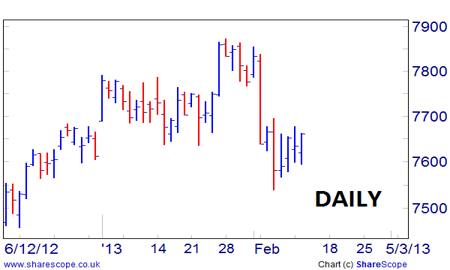Dow resurgent
There is no question in my mind that the major bull market in equities that began in 2009 is a genetically modified affair. Without the intervention of the mad scientists of the world's leading central banks, I neither believe the Dow Jones would today be back above 14000 nor the FTSE 100 above 6300, or anywhere near these levels. Therefore, we equally need to keep a close eye on those scientists' activities, as well as on the taurine motions on the charts.
I saw an excellent graph this week on Tom McClellan's website (http://bit.ly/XzUGib), showing the course of the S&P 500 index plotted alongside the size of combined balance sheets of the Federal Reserve and the European Central Bank (ECB). The story is simple and compelling: when the scientists inject the beast with their monetary concoctions, it stampedes higher. On those occasions where they have withdrawn the needle, the beast's legs have buckled beneath it.
Right now, as Mr McClellan points out, the Fed and ECB's combined balance sheets are actually shrinking, thanks to the ECB. He highlights a previous episode where shrinkage coincided with a rising stock market, around early 2010. What followed was the vicious near-bear market of April-June 2010. That unhappy period was only ultimately decided in the bulls' favour once the Fed promised yet another mega-dose of anabolic steroids to the herd.
Germany spills over
The shrinkage of the ECB's balance sheet may already be having an effect where one would most expect it to, in the continental European bourses. Germany's DAX 30 and France's CAC 40 gave change-of-trend sell signals on their swing charts back on Monday, 4 February. Spain's IBEX 35 has also dropped hard, even though it remains in an uptrend on its swing chart. I am concerned by the shrinkage, given that I believe the eurozone crisis is far from over.
Central banks bulking up
The accompanying chart shows the major central banks' balance-sheet data as of the end of January. I've put the figures into US dollars, to make them comparable. However, this has also exaggerated the asset shrinkage, as the euro and the Japanese yen have been rising against the dollar. The Japanese authorities, in particular, are aggressively trying to pump equities over there higher. So, with the US and Japan still bent on breeding Frankenstein cattle, it surely makes sense to look for opportunities in these markets, rather than in Europe for now.
Nikkei's Weigu beef
The uptrend in Japan's Nikkei 225 is a thing of beauty. I have to confess, I do not trade this market much, partly because its active hours are mainly when I'm asleep. That clearly doesn't deter others, though. As of Wednesday 13 February, just over two-thirds of the clients of IG Index, the spread betting firm, who have positions in the Nikkei are long. By contrast, 80 per cent of the clients with positions in the S&P 500 are currently short. I am still seeking long positions in the latter, though. The bull market in stocks is not ready for the slaughterhouse yet.















